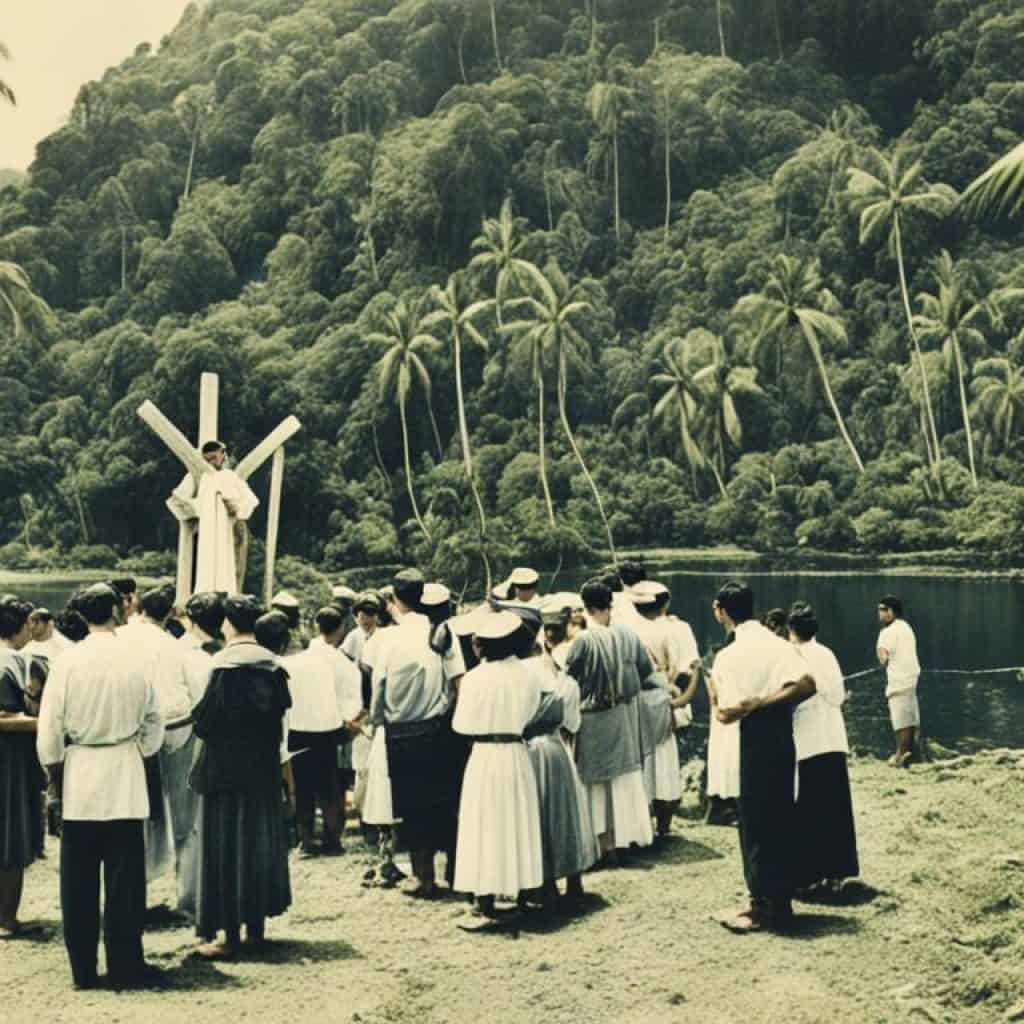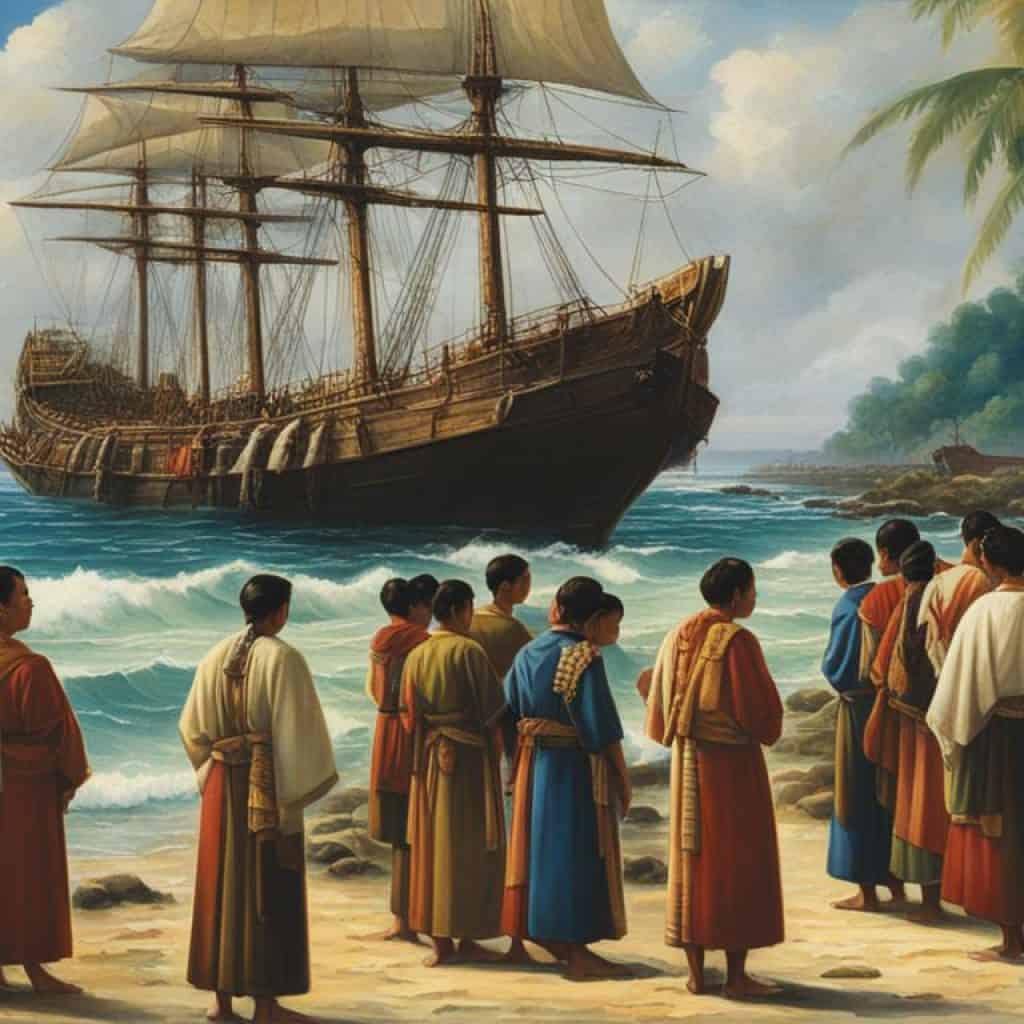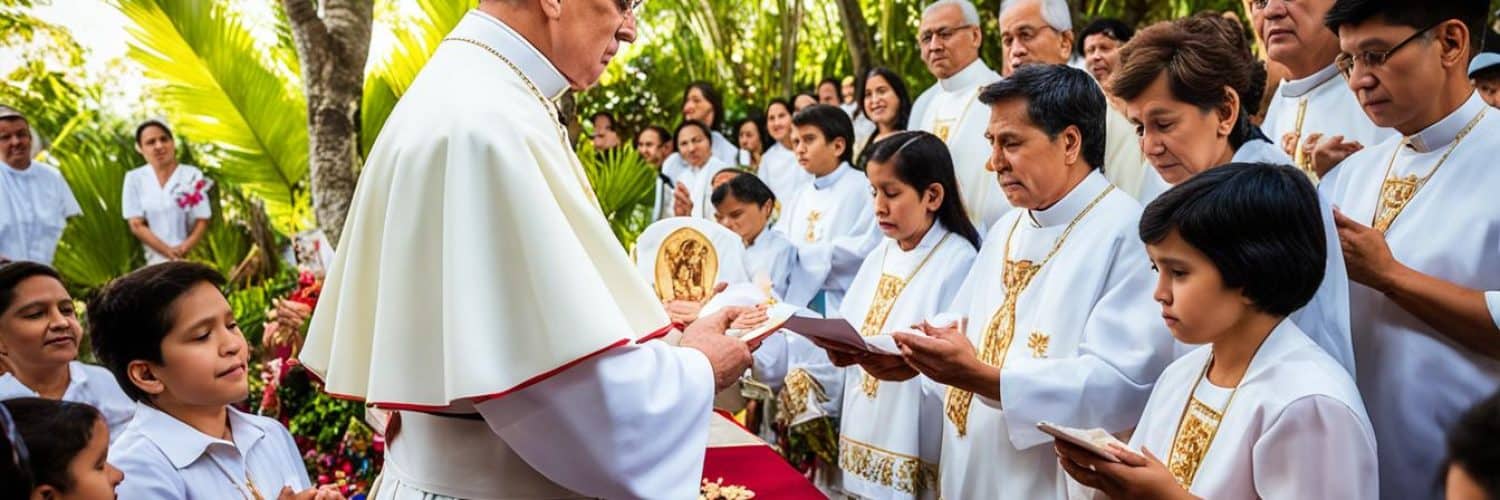Imagine a moment in history that forever shaped the religious landscape of a nation. A single event that introduced a new faith and sparked a cultural transformation. What if I told you that this moment unfolded in the Philippines, during the era of Spanish colonization? What if I told you it happened on Easter Sunday, April 1521? This is the story of the first documented Catholic Mass in the Philippines, a historical event that marked the birth of Christianity in the archipelago and continues to hold immense significance in Philippine history.
In this article, we delve into the details surrounding this pivotal moment, exploring the role of religion in the Philippines, the arrival of Ferdinand Magellan’s expedition, and the historical accounts of the first mass. We also address the controversy over the location and the significance of this event in shaping the religious and cultural heritage of the nation.
Join us on this journey through time, as we uncover the truth behind the first Catholic Mass in the Philippines and its profound impact on the history of the nation.
Key Takeaways:
- The first Catholic Mass in the Philippines took place on Easter Sunday, April 1521, during the era of Spanish colonization.
- This event marked the introduction of Christianity in the archipelago and played a significant role in shaping Philippine history and culture.
- The location of the first mass has been a subject of debate, with evidence pointing to Mazaua, now known as Limasawa, as the most likely site.
- Historian Dr. Antonio Sanchez de Mora’s research confirmed Limasawa as the official location of the first mass through the analysis of historical documents and maps.
- Despite differing interpretations of its impact, the first mass remains a pivotal moment in Philippine history, symbolizing the birth of Roman Catholicism in the archipelago.
Arrival in the Philippines
In 1521, the renowned Portuguese explorer Ferdinand Magellan embarked on an ambitious expedition from Sanlúcar de Barrameda, Spain. He set sail with the goal of discovering a new route to the spice-rich lands of the East Indies. After a arduous journey, Magellan and his crew finally reached the Philippines.
“We spotted a flickering bonfire in the distance, drawing us closer to our destination,” Magellan wrote in his journal. “Little did we know that this would be the beginning of a historic encounter.”
The bonfire turned out to be on the island of Mazaua, which is now believed to be the present-day Limasawa. On March 28, 1521, Magellan’s expedition anchored near Mazaua, marking their official arrival in the Philippines.
Excited and eager to explore this new land, Magellan and his crew made contact with the locals, igniting a series of events that would shape the course of history.
Encountering the Locals
As Magellan and his crew interacted with the people of Mazaua, they were met with curiosity and hospitality. The locals, who had never seen Europeans before, welcomed the explorers with open arms.
During their time in Mazaua, Magellan and his crew exchanged goods and established friendly relations with the native inhabitants. This initial encounter would set the stage for future interactions between the Spanish and the indigenous people of the Philippines.
| Significance of Magellan’s Arrival in the Philippines | Evidence |
|---|---|
| Introduction of European presence in the Philippines | Accounts from Magellan’s crew members |
| Pave the way for Spanish colonization | Historical records from the Spanish era |
| Beginning of cultural exchange between Europe and the Philippines | Artifacts and cultural influences from Spanish colonization |
Magellan’s arrival in the Philippines was a pivotal moment in history. It marked the beginning of European presence in this part of the world and laid the foundation for centuries of Spanish influence and colonization. The encounters between Magellan’s crew and the locals opened up a new era of cultural exchange and shaped the course of the Philippines’ future.
Historical Accounts of the First Mass
One of the notable eyewitnesses to the first mass in the Philippines was Antonio Pigafetta, an Italian traveler who joined Ferdinand Magellan’s expedition. Pigafetta chronicled his experiences in a diary titled Primo viaggio intorno al mondo (First Voyage around the World).
In his diary, Pigafetta detailed the events from the sighting of the Philippine islands on March 16, 1521, to the landing in Cebu on April 7, 1521. His account provides valuable insights into the exploration of the archipelago and the interactions with the locals.
Specifically, Pigafetta mentions the celebration of a mass on Easter Sunday, which marked a significant moment in the expedition’s religious journey. However, there is some discrepancy regarding the mention of a Palm Sunday mass, which further adds to the complexity of understanding the exact sequence of events surrounding the first mass.
Despite these discrepancies, Pigafetta’s eyewitness account serves as an important historical record of the first mass and illuminates the early days of Spanish exploration and the introduction of Catholicism to the Philippines.
Controversy over the Location
Despite the historical significance of the first Catholic Mass in the Philippines, there has been ongoing debate surrounding its exact location. While some proponents argue that it took place in Butuan, others strongly believe it occurred in Limasawa.
This conflicting belief has sparked a thorough investigation by the National Historical Commission of the Philippines. In recent years, the Commission has diligently reviewed the evidence and arguments presented by both sides, aiming to establish the truth.
After careful analysis, the National Historical Commission of the Philippines has concluded that the evidence in favor of Limasawa as the site of the first mass is more compelling. They have officially affirmed Limasawa as the location where this significant historical event took place.

Blood Compact and Cross Planting
Upon their arrival in Mazaua, Ferdinand Magellan and his crew formed a deep friendship with Rajah Kolambu and his brother Rajah Siagu. To seal their newfound bond, they performed a blood compact, a customary ritual in Southeast Asia. This sacred act symbolized their commitment, trust, and loyalty to each other, transcending language and cultural barriers.
“The blood compact between Magellan and Rajah Kolambu was a powerful expression of friendship and mutual respect. It embodied the essence of brotherhood and served as a foundation for future interactions between the Spanish and the native people of the Philippines.”
Furthermore, as an enduring symbol of their presence and the introduction of Christianity, Magellan ordered the planting of a large wooden cross on a hill overlooking the sea. This act carried deep spiritual significance, representing the cross as a universal symbol of faith, hope, and redemption. The cross served as a beacon of light, casting a visual reminder of the transformative power of the Christian message.
Significance of the First Mass
The first mass held on Easter Sunday, 1521, marked the birth of Roman Catholicism in the Philippines. It played a significant role in the Christianization of the archipelago during the era of Spanish colonization. The introduction of Catholicism shaped the nation’s faith, cultural identity, and history. While the immediate impact may not have resulted in the establishment of a lasting Christian community, it set the foundation for future evangelization efforts.

“The introduction of Catholicism shaped the nation’s faith, cultural identity, and history.”
The first mass held on Easter Sunday, 1521, in the Philippines was a pivotal moment in the birth of Roman Catholicism in the country. This event marked the official introduction of Christianity during the time of Spanish colonization, with lasting implications for the faith and cultural identity of the Filipino people.
The impact of the first mass goes beyond its immediate consequences. While it may not have established a lasting Christian community at that time, it laid the groundwork for future evangelization efforts that would shape the religious landscape of the Philippines. The Catholic faith became deeply ingrained in the Filipino culture, influencing various aspects of daily life, celebrations, and traditions.
Through the dissemination of Catholic teachings and practices, the first mass initiated the process of Christianization in the Philippines. It played a crucial role in shaping the religious beliefs and values of the Filipino people, affecting their worldview, moral compass, and social structures.
Moreover, Catholicism played a significant role in the development of Philippine history. It became intertwined with the struggles for independence and social justice, providing a framework for resistance against colonial rule and inspiring movements for social change.
“The introduction of Catholicism to the Philippines marked a turning point in the country’s history, leaving a lasting impact on its religious, cultural, and social fabric.”
The significance of the first mass cannot be overstated. It paved the way for centuries of Catholic influence in the Philippines, shaping the nation’s religious landscape and leaving a profound impact on its people. Roman Catholicism continues to be the dominant religion in the country, with its traditions and values deeply embedded in Filipino society.
“The first mass in the Philippines marked the birth of Roman Catholicism in the archipelago, setting the stage for the Christianization of the nation and leaving a lasting impact on its cultural and religious identity.”
Confirmation by Spanish Medieval History Expert
In our quest to unravel the truth behind the first Catholic Mass in the Philippines, we sought the expertise of Dr. Antonio Sanchez de Mora. As a renowned expert on Spanish medieval history and the head of the reference service at the Archivo General de Indias in Seville, Spain, Dr. Mora’s insights shed light on this historical event.
With access to a wealth of historical sources, Dr. Mora meticulously examined documents, reports, testimonies, and maps from the 16th century. After an extensive analysis, he reached a decisive conclusion. According to his research, the island of Mazaua, now known as Limasawa, was indeed the site of the momentous Easter Sunday Mass on March 31, 1521.
Dr. Mora’s findings provide vital validation and clarity to the ongoing discussion surrounding the first mass in the Philippines. By delving deep into the historical archives, he has reinforced the claims and assertions made by those who advocate for Limasawa as the authentic location. His expertise has added weight and authority to the historical significance of this event.
“The historical records and evidence unequivocally point to Mazaua, present-day Limasawa, as the place where the first Catholic Mass in the Philippines occurred,” Dr. Mora affirmed confidently.
The confirmation by Dr. Antonio Sanchez de Mora helps solidify the historical narrative surrounding the first mass and its pivotal role in the Christianization of the Philippines. The continued exploration and examination of historical sources ensure that the accurate representation of this event is preserved and celebrated.
| Key Aspects | Confirmation by Dr. Antonio Sanchez de Mora |
|---|---|
| Historical Expertise | Expert on Spanish medieval history and head of reference service at the Archivo General de Indias |
| Research Scope | Extensive analysis of 16th-century documents, reports, testimonies, and maps |
| Conclusion | Limasawa (formerly Mazaua) is the site of the Easter Sunday Mass on March 31, 1521 |
| Validation | Provides authority and credibility to the claims supporting Limasawa as the location |
Shift in Beliefs and Historical Debate
For many years, the belief that Butuan City was the location of the first mass in the Philippines was widely accepted. However, a significant historical correction shifted this belief to Limasawa. This correction was made by historian Trinidad Pardo de Tavera in 1921, and since then, multiple panels convened by the National Historical Institute have affirmed Limasawa as the official site.
The historical correction regarding the location of the first mass has sparked a passionate debate among scholars and historians. The Limasawa tradition has gained prominence as evidence in support of the Easter Sunday mass held on March 31, 1521. The rich historical legacy of Limasawa has brought attention to its significance in Philippine history and culture.
The National Historical Institute diligently examined and analyzed various sources and accounts related to the first mass. Through meticulous research and careful consideration, they arrived at the conclusion that Limasawa is indeed the authentic site of the first Catholic mass in the Philippines.
“The historical records and testimonies provided compelling evidence supporting Limasawa as the location where the first mass took place. The National Historical Institute stands firm in its assessment, affirming the rich historical heritage of Limasawa.”
The National Historical Institute’s Conclusions:
- The first mass in the Philippines was held on March 31, 1521.
- The official site of the first mass is Limasawa, not Butuan City.
- Historical correction affirmed by multiple panels.
These conclusions offer clarity and provide a foundation for understanding the historical significance of the first mass in the Philippines. It is essential to recognize the importance of accurate historical documentation and the ongoing efforts to preserve and protect our cultural heritage.

Importance of the First Mass
While there is debate over the location of the first mass, its exact significance is a matter of interpretation. Some argue that the mass had little impact in terms of establishing a lasting Christian community in the Philippines. Magellan’s expedition was primarily focused on finding a western trade route, and the mission to spread Christianity would not bear significant fruit until several decades later.
Conclusion
The first Catholic Mass in the Philippines held on March 31, 1521, was a historic event of great significance that has left a lasting impact on the nation’s cultural heritage. Despite the debate over the exact location, the evidence strongly indicates that the mass took place in Mazaua, now known as Limasawa. This event marked the introduction of Christianity to the Philippines during the era of Spanish colonization, setting the stage for the development of religious traditions in the archipelago.
The first mass not only played a pivotal role in the spread of Catholicism but also served as a significant milestone in Philippine history. It symbolizes the beginning of a new era, where the influence of Catholicism would shape the nation’s identity and shape the course of its history.
The historic significance of the first mass lies in its cultural and religious impact. It paved the way for the conversion of many Filipinos to Catholicism and set the foundation for the Christianization of the archipelago. The introduction of Catholicism brought about profound changes in the religious and social fabric of the Philippines, leaving an indelible mark on its traditions and customs.
The first Catholic Mass in the Philippines was not merely a religious ceremony but a symbol of Spanish colonial power and influence. It represented the Spanish conquest and the imposition of European beliefs and practices on the indigenous population. The mass was a manifestation of the Spanish crown’s aim to strengthen its hold on the Philippines and propagate Catholicism as the dominant faith.
Despite the differing interpretations of its impact and the ongoing debate surrounding its exact location, the first Catholic Mass in the Philippines remains a significant event in Philippine history. It serves as a reminder of the complex and intertwined narratives of colonization, religion, and cultural heritage.
As we reflect on this historic occasion, we can appreciate the fusion of cultures and the enduring legacy of the first mass. It stands as a testament to the Filipino people’s resilience, adaptability, and ability to forge their own identity amidst the challenges of history. The first Catholic Mass in the Philippines continues to be a source of pride for Filipinos, serving as a reminder of their rich cultural heritage.
| Table | Significance of the First Mass |
|---|---|
| 1 | Introduction of Christianity to the Philippines |
| 2 | Shaping the nation’s cultural and religious heritage |
| 3 | Foundation for the spread of Catholicism |
| 4 | Symbol of Spanish colonial power and influence |
| 5 | Complex narratives of colonization and cultural assimilation |
Conclusion
The first documented Catholic Mass in the Philippines took place on March 31, 1521, Easter Sunday. Under the guidance of Father Pedro de Valderrama, this religious introduction marked the beginning of Christianity in the Philippines during Spanish colonization. This significant historical event has left a lasting impact on the nation’s faith and cultural identity.
While there may be ongoing debate about the exact location of the first mass, evidence points towards Mazaua, now believed to be present-day Limasawa. Despite conflicting beliefs, the National Historical Commission of the Philippines has affirmed Limasawa as the official site, based on historical accounts and evidence.
The first mass holds a prominent place in Philippine history, symbolizing the role of religion and the significance of Catholicism in the country. It paved the way for the Christianization of the archipelago and laid the foundation for future evangelization efforts. April 1521 forever stands as a milestone in Philippine history, marking the beginning of a religious and cultural transformation.


















Add comment